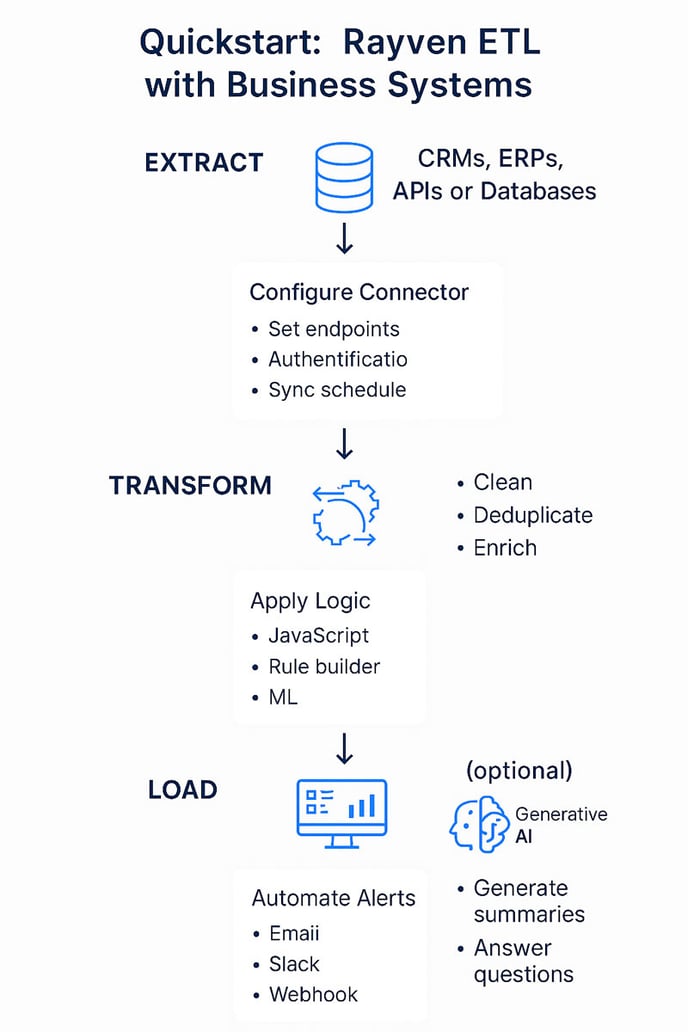ETL (Extract, Transform, Load) is a core capability in Rayven.io that helps you build real-time, automated workflows across CRMs, ERPs, databases, and support systems.
Overview
ETL (Extract, Transform, Load) is a core capability in Rayven.io that helps you build real-time, automated workflows across CRMs, ERPs, databases, and support systems. Whether you're synchronizing sales data, cleaning order logs, or enriching support tickets with AI, Rayven's ETL engine gives you a flexible, no-code way to build reliable data flows — all in real time.
1. Extract: Bringing Data into Rayven

What It Does
The Extract phase pulls data from diverse sources across your business systems.
Supported Sources
-
CRMs (e.g., Salesforce, HubSpot)
-
ERPs (e.g., SAP, NetSuite)
-
Databases (MySQL, SQL Server, Snowflake)
-
Cloud Storage (e.g., AWS S3, Google Drive)
-
Web APIs (e.g., Zendesk, Stripe, Workday)
How It Works
-
Use prebuilt connectors to configure real-time or scheduled ingestion
-
Set credentials, endpoints, and mapping rules
-
Ingest data as JSON, XML, CSV, or direct API streams
Example: Ingest customer order updates from NetSuite using a scheduled API pull every 15 minutes.
2. Transform: Applying Business Logic
What It Does
The Transform phase applies cleaning, enrichment, and calculation rules to ensure the data is usable and meaningful.
Available Functions
-
Filtering: Remove duplicate or irrelevant entries
-
Aggregation: Summarize (e.g., total revenue per customer)
-
Calculations: Apply formulas (e.g., gross margin = revenue - COGS)
-
Custom Logic: Add JS or use rule builder nodes
-
Lookup Mapping: Enrich records with data from other tables (e.g., region codes, manager names)
How It Works
-
Use Rayven’s Workflow Builder to chain logic visually
-
Configure nodes with formulas, thresholds, or group-by conditions
-
View real-time output previews to validate transformations
Example: Clean a support log by removing empty fields, then calculate average resolution time by support rep.
3. Load: Sending Data Where It’s Needed
What It Does
The Load phase delivers cleaned, processed data into downstream systems or UI components.
Destinations
-
Dashboards: Display summaries in charts, KPIs, and tables
-
Rayven Tables: Store processed records for audits, analytics, or further automation
-
External APIs: Sync back into CRM, ERP, or reporting tools
-
Automated Alerts: Trigger emails, Slack messages, or system notifications
How It Works
-
Use Output Nodes to configure your destination
-
Push full records or summaries
-
Trigger loads based on events, schedules, or workflow conditions
Example: Push daily revenue summaries to a “RevenueSummary” table and auto-email finance managers a snapshot report.
4. ETL + AI: Rayven's Intelligence Layer
Real-Time Operation
All ETL pipelines run continuously — perfect for time-sensitive operations like lead scoring, support prioritization, or compliance monitoring.
ML Integration
You can embed AI into your pipeline to predict or classify data:
-
Flag churn-risk customers
-
Predict next purchase date
-
Score leads from marketing systems
Generative AI Integration
Rayven lets you embed Generative AI into workflows to:
-
Create natural language summaries
-
Auto-generate reports or alerts
-
Enable conversational interfaces via chat widgets
5. Example: ETL with CRM + Finance Integration
1. Extract
-
Source: Customer interaction data from HubSpot and transaction data from Stripe
-
Method: API calls every 15 minutes
2. Transform
-
Normalize timestamps and clean email fields
-
Aggregate total spend per customer
-
Detect duplicate records and consolidate
3. Load
-
Store cleaned data in Rayven Tables
-
Push updated records into Salesforce via API
-
Display summary KPIs in the Sales dashboard
4. Explain (Generative AI)
-
Generate summaries per customer:
“Customer A had 12 new interactions and spent $4,200. No issues detected.” -
Auto-send a daily digest to account managers
-
Enable chatbot queries:
“Which enterprise clients spent more than $10k last week?”
6. How Rayven ETL Differs from Traditional Tools
| Feature | Traditional ETL | Rayven ETL + GenAI |
|---|---|---|
| Timing | Batch | Real-time |
| AI Integration | External + Manual | Native ML and Generative AI |
| Alerts | Static thresholds | Dynamic, human-readable notifications |
| Interaction | Code + pipeline configs | Drag-and-drop + chatbot integration |
7. Frequently Asked Questions (FAQ)
Q: Can I connect multiple business systems into one ETL pipeline?
A: Yes. You can pull data from CRM, ERP, and databases into a single workflow.
Q: Can Rayven clean and deduplicate records before syncing to Salesforce?
A: Absolutely. Use transformation nodes to remove duplicates, fix email formats, and consolidate leads.
Q: Can I automate end-of-day reports to my team?
A: Yes. Use Generative AI to create summaries and Email or Slack nodes to send them automatically.
Q: Do I need to write code to use Rayven ETL?
A: No. You can build workflows visually, but JavaScript is available if advanced logic is needed.
Q: Can I enrich support tickets with product or customer data during ETL?
A: Yes. You can join or lookup additional fields from other tables or APIs during the transform phase.
Q: Can Generative AI support different summaries per user group?
A: Yes. Use filters or group IDs to generate role-specific summaries (e.g., finance, ops, marketing).
